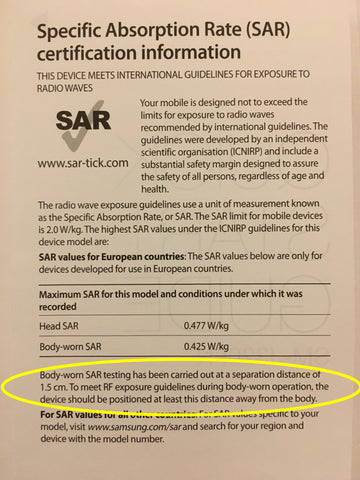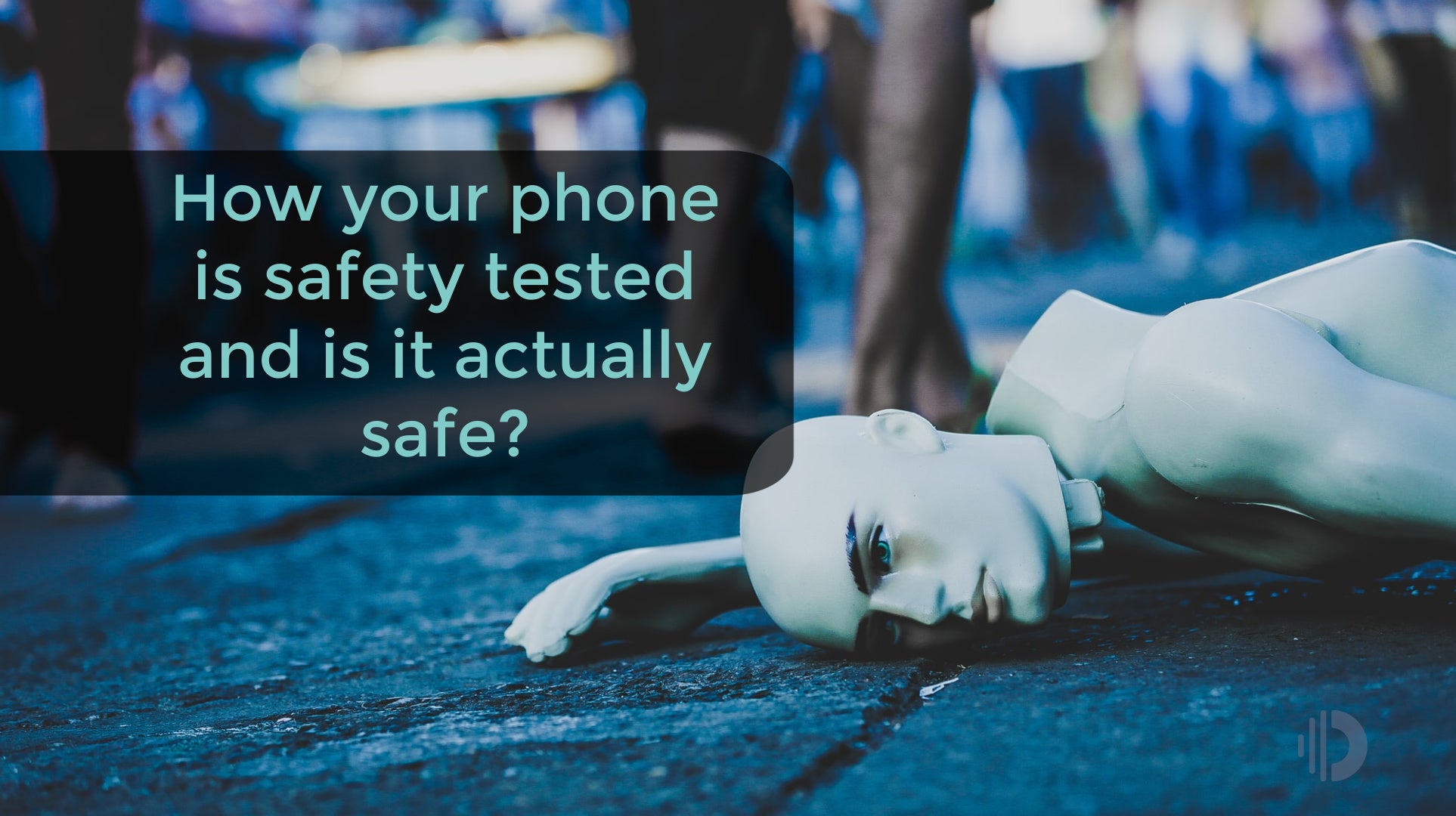We are all holding a phone that we assume has been rigorously tested for health and safety, but do you know how the phone industry tests the safety of your phone?

We’ll preface this by saying that every phone does have to go through testing to ensure its safety and that there are various agencies around the world that define what is considered safe. We also want to add the disclaimer that we're here to share factual information with you, and we expect you to make your mind up about safety levels and the efficacy of the current testing standards.
The test these agencies and labs use for safety testing is called the Specific Absorption Rate (SAR) Test.
Dave Weaver of UL Labs defines “SAR is a measurement of how much energy a user of, say, a cell phone is receiving.”
What is the SAR Standard?
The Specific Absorption Rate standards say that all cell phones must meet the FCC’s radiofrequency (RF) exposure standard. It refers to the amount of heat or energy that is absorbed by a human body when it is exposed to a mobile phone.
There are a few variant standards but we will take the limit set by ICNIRP (the International Commission on Non-Ionizing Radiation Protection). Their safety threshold is 2 Watts per Kilogram (of human flesh).
This standard has stood since 1996. That is a long time ago, and the threshold hasn't been increased since, despite a meteoric rise in the amount of data that phones can process and functions that apps can perform. There was a review of this level in 2020 and they opted not to change it.
In recent years, phones have become far more data-hungry. When a phone demands more data, it pulls the data in through ever more intense RadioFrequency electromagnetic fields (RF-EMF). The phone pulls in more microwave radiation to the phone and in doing so, can create more heat.
So we have a situation where the safety standard has stayed the same but the phones have significantly increased in the amount of radiation that they produce. It is a rational conclusion to reach that phones have become hotter than they were 10 years ago.
At What level of Heat do Health Effects Occur?
This is actually very difficult to determine. The science behind the 2w/kg safety threshold is based on the whole body average specific absorption rate needed to increase the core temperature by 1 degree Celsius. This, of course, varies person to person and is different depending on factors like age, weight, height, and sex.
However, we want to point out here that these standards have not been changed since 1996 even in the light of the epidemic of phone and wireless radiation that has surged exponentially over these last 20 years.
Although in 2013, the FCC did vote that they should do an inquiry into whether the current standards are actually safe. They also renewed that decision in 2019, that is the decision that they should look into their own standards, but they have not done that yet. Nor have they updated those safety standards.
'Phonegate': the Controversy over How SAR is now Measured
Dr Marc Arazi is a french physician who has been investigating a recent development in the way that SAR is measured. What he found was something he believe to be a scandal similar to what was dubbed 'Diesel Gate', where the car manufacturer Volkswagen intentionally programmed their cars to emit less pollution when tested than they do in real life.
What had happened is that the phone industry had changed the terms and conditions on each phone so that they now stipulate that the phone has to be held at least 5mm (and up to 1.5cm) away from the body at all times. The trouble is that these are touchphones. We are touching them and you can not type on a touchphone without breaking the new SAR threshold of 5-15mm.
Dr Arazi measured that phones were tested directly next to the body, they exceeded the SAR limits more than 300%. His findings can be found in Tim's video about phone safety standards here:
Why did the phone industry make this change to the way that phone radiation is SAR tested? Why did they specify that phones should at all times be held at least 5mm away from the body?
Well, it could be because the phones started to become so powerful that they were all producing much more heat, and therefore creeping above the SAR testing limit of 2 W/Kg and rather than increasing this threshold, it was deemed less risky to make new specifications about how users must use their phones. However, if this is the case, then please note that no changes to the design of a phone have been made to account for this. They are all still touch phones.
Do the Specific Absorption Rate (SAR) Tests ensure that we are Safe?
The first thing to ask is: have any tests been done on living, breathing organisms that indicate that levels of less than 2W/Kg is harming animal tissue. The answer is: yes. For this we will quote the BioInitiative Report from 2011 [1] and show just one page of its findings in summary here:
|
SAR (Watts/Kilogram) Reference |
Finding | Study |
| 0.5 W/Kg | 900 MHz pulsed RF affects firing rate of neurons (Lymnea stagnalis) but continuous wave had no effect | Bolshakov, 1992 |
| 0.58 - 0.75 W/Kg | Decrease in brain tumors after chronic exposure to RFR at 836 MHz | Adey, 1999 |
| 0.6 - 0.9 W/Kg | Mouse embryos develop fragile cranial bones from in utero 900 MHz The authors say "(O)ur results clearly show that even modest exposure (e.g., 6 min daily for 21 days" is sufficient to interfere with the normal mouse development process". | Fragopoulou, 2009 |
| 0.6 and 1.2 W/Kg | Increase in DNA single and double-strand DNA breaks in rat brain cells with exposure to 2450 MHz RFR | Lai & Singh, 1996 |
| 0.795 W/Kg | GSM 900 MHz, 217 Hz significantly decreases ovarian development and size of ovaries, due to DNA damage and premature cell death of nurse cells and follicles in ovaries (that nourish egg cells) | Panagopoulous, 2012 |
| 0.87 W/Kg | Altered human mental performance after exposure to GSM cell phone radiation (900 MHz TDMA digital cell phone signal) |
Hamblin, 2004 |
| 0.87 W/Kg | Change in human brainwaves; decrease in EEG potential and statistically significant change in alpha (8-13 Hz) and beta (13-22 Hz) brainwave activity in humans at 900 MHz; exposures 6/min per day for 21 days (chronic exposure) |
D'Costa, 2003 |
| 0.9 W/Kg | Decreased sperm count and more sperm cell death (apoptosis) after 35 days exposure, 2-hr per day | Kesari, 2012 |
| < 1.0 W/Kg | Rats exposed to mobile phone radiation on STANDBY ONLY for 11-hr 45-min plus 15-min TRANSMIT mode; 2 times per day for 21 days showed decreased number of ovarian follicles in pups born to these pregnant rats. The authors conclude "the decreased number of follicles in pups exposed to mobile phone microwaves suggest that intrauterine exposure has toxic effects on ovaries." |
Gul, 2009 |
| 0.4 - 1.0 W/Kg | One 6-hr exposure to 1800 MHz cell phone radiation in human sperm cells caused a significant dose response and reduced sperm motility and viability; reactive oxygen species levels were significantly increased after exposure to 1.0 W/Kg; study confirms detrimental effects of RF/MW to human sperm. The authors conclude "(T)hese findings have clear implicatiions for the safety of extensive mobile phone use by males of reproductive age, potentially affecting both their fertility and the health and wellbeing of their offspring." |
De Iuliis, 2009 |
| 1.0 W/Kg | Human semen degraded by exposure to cell phone frequency RF increased free-radical damage. | De Iuliis, 2009 |
We will pick out one such study from this list which shows effects observed at 1.2 W/Kg, which is less than 2w/kg which is what is the threshold in the SAR test, and this study is over 25 years old:
|
0.6 and 1.2 W/Kg Increase in DNA single and double-strand DNA breaks in rat brain cells with exposure to 2450 MHz RFR Lai & Singh, 1996 |
We must make it clear that one single Biological study on a real animal does not make any other safety test redundant. However, when several are taken together and show that Biological effects cans start at less than 2W/Kg, a case is built for contesting the safety protocols.
So in this table the biologists have provided evidence that in some tests, non-thermal, non-ionising wireless radiation is causing biological effects to rats at very low levels of radiofrequency. These low frequencies are known not to create much heat. It follows that there must be something other than 'heat' which is the root cause of the effects.
Omnia has a unique explanation for WHY animal tissue reacts to such low levels of microwave radiation, which we have explained here.
However, if you ask us: What is the safe SAR level? We do not truly know the answer to this question.
Doubts that have been Raised about SAR Testing
To summarise, the doubts that have been raised about the validity of SAR testing are fourfold.
1. The SAR safety thresholds have stayed the same for 25 years.
As mentioned before, the Terms and Conditions on almost all phones have been changed recently to statements like this one:
“Body-worn SAR testing has been carried out at a separation distance of 1.5 cm. To meet RF exposure guidelines during body-worn operation, the device should be positioned at least this distance away from the body.”

To position the phone 1.5cm away from the body means to never touch it.
Uh. We literally use phones called “touch phones!”
And we put these things against our brains.
After learning how the tests are conducted we have a few other concerns regarding the adequacy of the SAR test:
2. Specific Absorption Rate is not a biological test.
Labs use plastic dummies which they nickname 'Specific Anthropomorphic Mannequin (or 'SAM') which are filled with synthetic blood that is comprised of basic chemical compounds like sugar, salts, oils, and water to do their tests. We’re not pro-animal testing, but we question whether a non-living chemical compound can represent animal blood.
We are also aware that all cells in the human body have electrical current spinning around them and without using live blood, these tests are missing how the electrical currents in the human body will respond to a wireless device.
3. The tests aren’t always done before a device is on the market
Dale blatantly states that it would be nice if device makers sent devices for testing before they go to market, but they often don’t. They have tight turnaround times on their tests and that limits what they can achieve before they make it into the hands of consumers.
4. Testing is not representative of how we actually use phones
There is always a separation specification, and that’s where the testing is done - not next to your head, not in the pocket - where most people are carrying their phone. His suggestion is basically, “people are carrying it wrong” rather than, we test where people actually use it (against their heads).
So is SAR Testing Safe?
In our opinion, this safety test is lacking.
Until all scientists agree on the best way to measure the response in a real, live animal between the electrical current in living cells and the electrified wave fields of microwave radiation, then we believe that we have an inadequate and flawed methodology.
Omnia’s solution is based on new science which unveils a different quality in a radiation field that can cause imbalance in the human body. We call it the ‘uncentred-ness (or imbalance) of the wave field’.
The imbalance we detect in the human body in our test results is not caused by heat, nor any 'Specific Absorption' of heat from the radiation wavefield. It caused by the electrical imbalance.
While we wait for the industry and the biologists to agree on more stringent and representative testing standards that are based on how we actually use phones, laptops and all wireless devices, and until we can see that the results give us a confident assurance that the testing process has demonstrated safe use, we suggest taking other measures to ensure your own safety.
-----
References
BioInitiative Report extract from summary of tests
ICNIRP Guidelines for Limiting Exposure to Electromagnetic Fields
FCC Radio Frequency Safety Pag




Share and get 15% off!
Simply share this product on one of the following social networks and you will unlock 15% off!